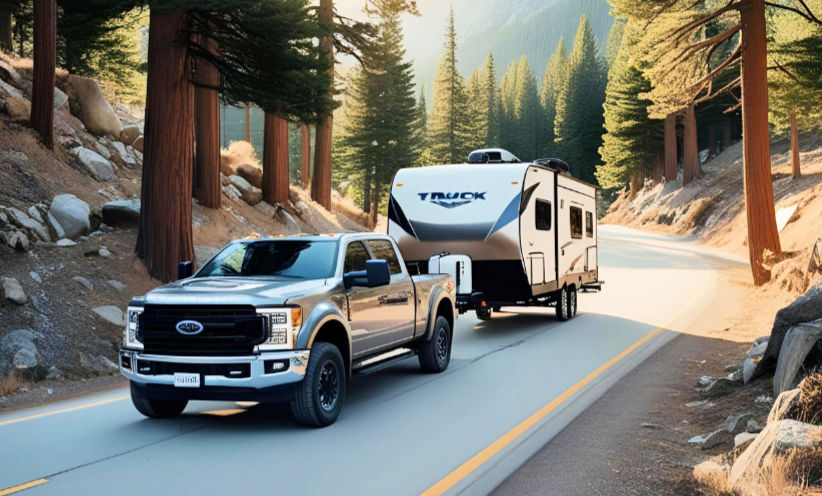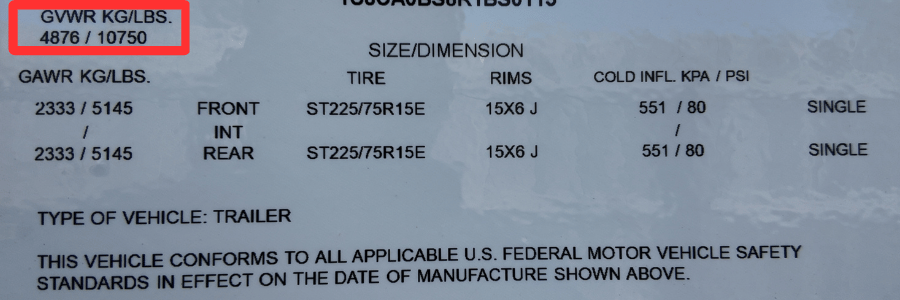How Much Truck Do I Need? – The Basics of Understanding Towing Capacity
- Just CAMP Wait
- Mar 9
- 5 min read
Updated: Mar 26
Imagine finding your dream travel trailer and discovering the hard way that you just don’t have enough truck to tow it safely. Even worse yet, imagine not realizing you don’t have enough truck and becoming another statistic after you lose control of your vehicle while driving down the highway. I’ve seen far too many rigs on the highway at risk of catastrophe. Towing a travel trailer safely means ensuring you’re within the limits of what your vehicle can safely handle, but how do you know if your vehicle is up to the task? That one guy at work says I need the biggest diesel truck on the lot! The salesman at the RV dealer says a half-ton truck can pull that 40-foot rig no problem. Let’s see if we can’t find a more solid, fact-based answer…

The first place you need to be looking to determine how much weight your vehicle can tow is the owner’s manual or manufacturer’s towing guide. You can often find the manufacturer’s towing guide you are looking for with a simple Google search if you no longer have it stashed away in your glove box. Once you’ve located the guide you need, you’ll need to identify the specific vehicle configuration you have and ensure that you follow the notes on the chart to identify the maximum weight you’re able to tow.
Once you have your vehicle’s max tow weight number, you’re not done. The maximum towing weight listed in these charts is under the conditions set by the SAE J2807 specification manufacturing tests (post 2013 models) and it does not necessarily represent real-world conditions. It is a “maximum” capability and could easily turn an easy drive into a white-knuckle experience. I always recommend trying to stay somewhere around 80% or less of this maximum capacity. If you tow often, you will learn that adding some buffer into your
calculations can save you from a lot of problems down the road.
Vehicle Maximum Tow Rating x 80% = Optimal Towed Weight

Let’s get more specific about how much “capacity” your vehicle really has. In the door jam of your vehicle (post 2008) there should be a sticker showing the maximum cargo capacity or “payload” of your vehicle. This is hand calculated by subtracting the curb weight from the gross vehicle weight rating (GVWR) of your vehicle. The maximum cargo capacity represents how much total weight you can add to your vehicle without overloading it. This is important because you’ll be adding weight to the vehicle in the form of hitch weight or pin weight from your trailer. Be aware, the cargo capacity doesn’t include the weight of passengers, gear, hitches, pets, or anything else that you may have in or on your vehicle that wasn’t there from the factory. That’s all additional weight that will cut into your maximum cargo capacity. I recommend reducing your capacity slightly with 10%-20% buffer to make sure you leave some wiggle room for those unexpected shopping trips or that additional person that might be riding along.
Vehicle Rated Cargo Capacity x 90% = Optimal Cargo Capacity
Now that we know how much weight our vehicle can pull and how much weight capacity we have, it’s time to turn our attention to the trailer. We start by taking a look at how much our travel trailer actually weighs. On the front corner of the trailer there should be a vehicle information tag that lists the GVWR. The GVWR will be the weight of the trailer with the maximum allowable cargo. If the trailer GVWR is less than your vehicle’s maximum tow weight rating we looked at earlier, then you’re within the vehicle manufacturer’s specifications based on the weight of the trailer. Again, I highly recommend you aim to be at 80% or less of your vehicle’s max tow weight.

Optimal Towed Weight > or = Trailer GVWR
Next we’ll need to check that we aren’t exceeding the vehicle’s maximum cargo capacity. These calculations can differ depending on whether we are towing via a hitch or with a fifth wheel setup. So, we are going to look at both methods separately.
Let’s start by looking at what is called “pin weight” on a fifth wheel trailer. The pin weight is the amount of weight that will ride on the hitch in your vehicle instead of the trailer’s wheels. While many manufacturers list their “dry pin weight”, that isn’t very helpful since no one is going to be pulling into a campsite without any gear, food, water, or clothing in their trailer. We’ll need to estimate the pin weight of the trailer. Most modern fifth wheel travel trailers have 20% to 25% of their GVWR as pin weight. I always use 25% to make sure I leave some margin for error. So, simply take 25% of your trailer’s GVWR as an estimate of your pin weight. If your estimated pin weight is less than your vehicle’s cargo capacity when accounting for vehicle passengers and gear, then you are within manufacturers specification.
Trailer GVWR x 25% = Estimated Pin Weight

Time to take a look at what is called “tongue weight” on a traditional rear-hitch pulled trailer but first let’s take a look at the vehicle’s hitch itself. On the hitch or in the hitch manual there should be a rating for both weight distributing capacity and weight carrying capacity along with two columns for gross trailer weight and tongue weight. The weight distributing capacity is the maximum weight that the hitch can handle when using a weight distribution hitch setup and the carrying capacity is used when only a ball is used without distribution bars or chains. If the gross trailer weight on the hitch is less than your vehicle’s maximum tow weight rating, then the lower number should be used in calculating your maximum tow rating. If the carrying capacity on your hitch is less than your vehicle’s cargo capacity, then the lower number should be used to determine how much tongue weight your vehicle can handle.
Hitch Max Gross Trailer Weight > or = Trailer GVWR
Hitch Max Tongue Weight > or = Estimated Tongue Weight
Since we now understand how much tongue weight our vehicle can handle, let’s figure out how much tongue weight a properly loaded trailer has. As discussed before, we don’t want to use the manufacturer’s dry tongue weight in our calculations. Instead, we need to calculate the estimated tongue weight off of the trailer’s GVWR. Most modern travel trailers have between 10% and 15% of their weight on the tongue. I highly recommend using 15% when calculating your capacity to ensure you have some buffer built in so estimate your tongue weight as 15% of the trailer’s GVWR. If your tongue weight is less than your vehicle’s cargo capacity when accounting for vehicle passengers and gear and your tongue weight is less than your hitch’s maximum rated tongue weight, then you are within manufacturers specification. One additional note here is to remember that the hitch ball or system you use will need to have its weight added to the tongue weight. Some distribution systems can add 75lbs or more to your tongue weight.
Trailer GVWR x 15% = Estimated Tongue Weight
Now that we have these estimates figured out, you can safely estimate how much tow vehicle you need or how big of a trailer you can safely pull with the vehicle you currently own. Although I’m not going to discuss trailer loading specifics here, if you’re new to pulling a travel trailer be sure to evenly load the trailer with cargo to be sure you aren’t reducing your pin weight or tongue weight in order to avoid sway.
Estimated Pin Weight + Passengers/cargo < or = Vehicle Optimal Cargo Capacity
OR
Estimated Tongue Weight + Passengers/cargo < or = Vehicle Optimal Cargo Capacity